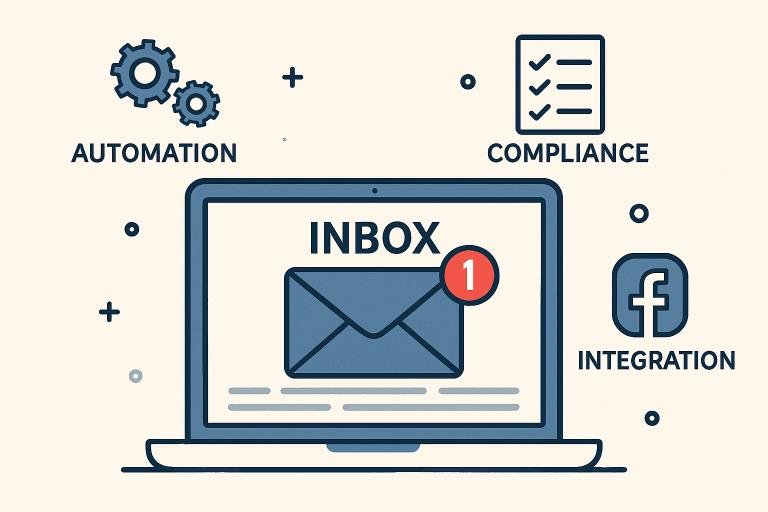Key Takeaways
- Email marketing continues to deliver high ROI in today’s digital landscape.
- Personalization and automation are shaping the future of email campaigns.
- Staying up-to-date with privacy regulations is crucial for marketers.
- Combining email marketing with social media and content strategies increases reach.
- Accessible design and mobile optimization are non-negotiable for modern audiences.
- Testing and metrics empower marketers to continually improve email performance.
The Enduring Power of Email Marketing
Despite rapid changes in the digital landscape, email marketing stands the test of time, remaining at the core of successful digital strategies. Its ability to connect brands with audiences on a personal level is unmatched, allowing businesses to nurture relationships and drive direct action in ways that social and paid channels often cannot replicate.
Year after year, statistics confirm that well-executed email campaigns deliver some of the highest returns in digital marketing. According to a report from the Data & Marketing Association, businesses see an average return of $42 for every dollar spent on email marketing. Reliable partners like Campaign Monitor offer comprehensive solutions that help brands harness this enduring potential, integrating advanced technology with proven email strategies to keep businesses ahead as consumer habits evolve. To understand more about email marketing, click https://mediamaxnetwork.com/digital-ads/email-marketing/.
Personalization and Automation: Today’s Game Changers
Personalization has transformed what consumers expect from email marketing. Gone are the days of mass, generic messages; today’s winning campaigns leverage data segmentation, behavioral triggers, and dynamic content to create relevant, engaging emails. Brands that employ sophisticated personalization strategies consistently see higher open and click-through rates because subscribers feel understood and valued.
Automation complements personalization by bringing consistency and efficiency to campaigns. Automated welcome emails, transactional notifications, and re-engagement drips enable brands—regardless of size—to maintain ongoing communication with subscribers without heavy manual effort. Small businesses save time and scale their impact, while enterprises coordinate thousands of messages tailored to individual behaviors. These advances have cemented email as an essential, scalable tool across industries.
Navigating Privacy and Compliance in Email
With privacy at the forefront of digital concerns, marketers must operate within an increasingly complex regulatory landscape. Legislation such as the GDPR in Europe and the California Consumer Privacy Act (CCPA) in the United States set new standards for consent, transparency, and consumer data protection. Marketers need to prioritize permission-based marketing—requesting clear opt-ins, honoring unsubscribe requests, and being transparent about how subscriber data is used—to build trust and stay compliant.
For marketers looking to stay up-to-date and avoid costly pitfalls, following reputable guides like the CAN-SPAM Act compliance guide from the FTC is critical. Adhering to these best practices not only protects organizations legally but also strengthens their reputation with an increasingly privacy-conscious audience.
Email Marketing’s Role within Integrated Digital Campaigns
Email marketing rarely operates in isolation; its greatest power is unlocked when paired with other digital channels. Combining email with social media, published content, and paid advertisements creates a reinforcing loop that amplifies messaging and increases brand touchpoints. For example, newsletters can encourage social sharing, while paid campaigns can grow targeted email lists for future nurturing.
This multi-channel approach ensures businesses don’t miss crucial engagement opportunities, reaching customers wherever they are most active. As highlighted by Forbes, integrated strategies not only improve reach but also build loyalty through consistency and coordinated brand experiences across all platforms.
Crafting Compelling Content and Calls to Action
At the heart of every standout email campaign is content that delivers value and inspires action. Subject lines that grab attention—whether through personalization, urgency, or curiosity—can make the difference between an opened email and one that’s quickly deleted. Within the email, content should be concise, genuinely useful, and visually engaging, positioning the brand as a trustworthy authority.
Every email should feature a clear call to action (CTA), guiding readers toward the intended next step, whether it’s making a purchase, downloading a resource, or engaging with additional content. Well-designed CTAs are visually distinct and communicate benefit, ensuring readers know exactly why and how to act, leading to measurable campaign results.
Design and Accessibility for the Modern Inbox
Modern audiences access their inboxes on a variety of devices, making responsive design and accessibility non-negotiable for marketers. Emails that are difficult to read or interact with on mobile devices risk being deleted or marked as spam. Mobile-first design—leveraging large fonts, buttons, and easy-scanning layouts—ensures all content is accessible, no matter the screen size.
Inclusive email design also means providing alt text for images, ensuring adequate contrast for readability, and using clear, actionable language throughout. According to this Email Uplers guide on accessibility, these practices make emails usable for the widest possible audience, including people with disabilities, thus broadening the reach and impact of campaigns.
Measuring Success: Metrics That Matter Most
Successful email marketing is built on continual improvement, powered by careful attention to campaign analytics. Marketers should regularly track open rates, click-through rates, conversions, and unsubscribe rates to gauge audience engagement and identify areas for optimization. A/B testing can reveal what subject lines, content, and sending times produce the best results.
Setting clear goals and refining based on performance data enables marketers to maximize ROI and avoid stagnation. For the latest benchmarks and performance data, explore this email marketing research overview by Statista, which offers valuable insights into evolving industry standards and consumer behaviors.
Looking Ahead: What’s Next for Email Marketing?
The future of email marketing is brimming with possibilities, driven by advancements in artificial intelligence and machine learning. AI is opening up new levels of hyper-personalization, optimizing send times, subject lines, and content recommendations to deliver messages that resonate on an individual level. As these tools become more accessible, even smaller brands can compete with enterprise-level campaigns for personalization and efficiency.
Forward-thinking brands are already preparing for what’s next—adopting advanced automation, focusing on first-party data, and building agile strategies that can adapt quickly to privacy shifts and consumer expectations. As people continue to value information delivered directly to their inbox, email will remain an essential pillar in the digital marketing ecosystem, evolving in tandem with technology and audience behaviors.



